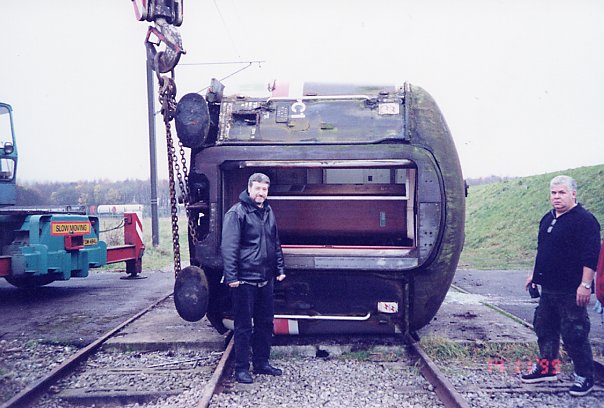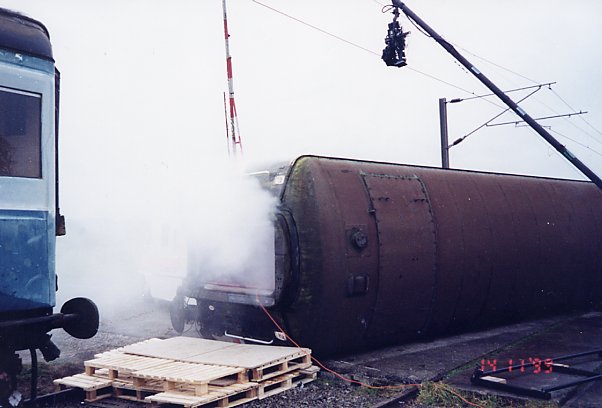EVACUATING AN OVERTURNED SMOKE FILLED RAIL CARRIAGE
Incidents requiring the rapid egress of passengers from trains are infrequent.
However, there is an obvious requirement to ensure that rail vehicle design and
crew procedures are adequate to allow the safe egress of passengers under a
variety of conditions. Perhaps the most challenging scenario for
passengers involves the evacuation from an overturned or partially overturned
carriage resulting from a crash or derailment. In the most severe cases,
fire/smoke may also be present. This report investigates the evacuation of
passengers from rail carriages with a focus on overturned carriages. This
is achieved through a study of passenger accounts from past accidents and two
full-scale evacuation experiments involving an overturned carriage, in one of
which the participants were subjected to non-toxic smoke. The carriage
used in the experiments is a standard class Mark IID, which while an old design,
shares many features with those carriages commonly found on the British rail
network.
The first trial without smoke resulted in passengers evacuating from both
ends of the carriage. The flow rate for a carriage end door lying on its
side with people displaying non-competitive behaviour is between 8.2 and 9.2
persons/minute producing an average flow rate capacity of 8.7 persons/minute.
Assuming this mean exit flow rate capacity, a full carriage load of 62
passengers would require approximately 3 minutes 43 seconds to evacuate through
both ends and 7 minutes 18 seconds through a single end. When smoke was
introduced into the carriage, the flow rate capacity for the carriage end door
lying on its side with people displaying non-competitive behaviour was found to
be between 4.7 and 5.2 persons/minute producing an average flow rate capacity of
5.0 persons/minute. It was further estimated that a full carriage load of
62 passengers would require approximately 13 minutes 19 seconds to evacuate
through a single end. The presence of smoke tends to almost half the exit
flow rate capacity and almost double the evacuation times.

MARK IID Carriage on its side showing external exit
with a person (~2m) for scale.

Carriage during smoke test, note the safety staging
by the exit.

Hurdle manoeuvre through internal partition
While these times are considered optimistic, they suggest that the time required to evacuate a full load of passengers from an overturned carriage subjected to these type of conditions are excessive. This suggests that given this type of scenario, only a hand full of those passengers lucky enough to survive the impact would be likely to survive the subsequent evacuation.
While preventing rail accidents should be the primary goal of the rail industry, improving the survivability of passengers involved in rail accidents must also be a high priority. The complexity of the U.K. rail network (a mix of underground, light rapid transit, commuter, intercity, and international systems) and the diversity of the rolling stock (type and age), makes generalising about safety difficult. However, this work has highlighted a number of issues that should be considered for further research.
1) Passenger luggage stored in overhead shelves is unsecured and free to move during incidents, especially those resulting in an overturned carriage. A means should be found to keep luggage secured in such events. This would reduce the amount of debris in the carriage making it easier for passengers to move. Furthermore, debilitating injuries caused by falling luggage would be reduced.
2) In the UK, carriage design typically incorporate numerous floor to ceiling obstructions such as full or partial partitions, hand grip poles etc. These obstructions pose considerable difficulties to passengers attempting to evacuate from an overturned carriage. These configurations should be reviewed and where the obstructions are found to serve no essential purpose, they should be reduced or removed.
3) Rapid evacuation from an overturned carriage through the normal means of entry requires an excessive amount of time and effort from the uninjured, it is virtually impossible for those passengers that are injured. The introduction of ceiling escape hatches that do not adversely affect the structural integrity of the carriage should be considered. Such devices would have the added benefit of allowing easier access for emergency workers and make removal of seriously injured passengers less difficult, reducing the likelihood of further injury.
4) Evacuating from a carriage with reduced visibility, resulting from for example the ingress of smoke, tends to slow the evacuation process by approximately 50%. Emergency lighting – similar to that found on aircraft and ships - should be considered for rail carriages. To be effective, the emergency lighting system should be independently powered on a carriage by carriage basis.
While not arising explicitly from evidence derived from these experiments, several other possible contributions to passenger safety arise from the study of past accidents and insight gained from these trials. These are:
5) In severe incidents, passengers are often killed or injured through the forces of impact, either being thrown from their seats into tables, walls, other passengers, or through windows. If not killed by such events, the resulting injuries are a hindrance to rapid egress and in some instances make it impossible for passengers to undertake the manoeuvres necessary to evacuate. Furthermore, while rail passengers tend to enjoy freedom of movement – especially on intercity trains - they spend the majority of their time seated, a situation not unlike that found on passenger aircraft. Consideration should therefore be given to the provision of passenger seat restraints such as lap belts.
6) In the UK, several carriage designs incorporate floor to ceiling luggage storage facilities at the ends of the carriage just before the sliding doors leading to the end of carriage vestibule areas. In the event of an overturned carriage, the evacuating passenger may be faced with several additional challenging obstructions making rapid egress difficult. Firstly, the luggage stored in these areas is not secured and can fall out creating a considerable blockage just ahead of the exit. Secondly, as seen in these experiments, the partitions forming the luggage storage area create a formidable barrier that passengers will have to climb over. Once over the barrier, the multiple luggage racks create a further obstacle for passengers forced to traverse this short passage in order to reach the exit. Consideration should be given to providing an alternative storage location for passenger luggage e.g. in locations between the seats and in facilities that do not stretch to the ceiling. Alternatively, a means should be found to secure the luggage in this area.
7) In some carriages operating on UK lines, the sliding doors in either end of the carriage leading from the passenger compartment into the vestibule area slide in the same direction. Consideration should be given to configuring carriages so that the doors open in opposite directions. In this way, should the carriage be in an overturned orientation, passengers are more likely to gain easier access to at least one end of the carriage.
8) Consideration should be given to improving safety related signage onboard
trains and the oral communication of safety information to passengers. In
particular, consideration should be given to the following:
- the introduction – at each stop on intercity services – of aircraft style
passenger safety briefings via the public address system,
- the introduction at each passenger seat of documentation in the form of a
leaflet containing information relating to emergency procedures and the location
and use of emergency equipment,
- the inclusion in the train operating companies free customer magazines of
information relating to general safety procedures and the use of emergency
equipment,
- the use of seat back entertainment systems – due to be introduced on some new
build UK rolling stock – for the delivery of safety information, and
- the use of light or sound locator systems to make the location of safety
equipment – such as emergency hammers in the case of UK trains – more prominent.
9) Insight into the evacuation efficiency of carriage design and passenger survivability issues can be gained from a detailed systematic study of the human factors associated with evacuation incidents. Actual detraining incidents – regardless of whether or not they are considered serious events – represent an invaluable resource, providing the rail industry with a natural human factors laboratory. Where possible, these incidents should be investigated and as many passengers and crew as practical interviewed. This information can be used to develop a database of human factors performance issues. Within the aviation arena, analysis of this type of data provides insight into evacuation issues and is challenging some of the unsubstantiated “common sense” views surrounding evacuation issues. As a minimum, the frequency and nature of detraining incidents across the network should be recorded by the industry.
It is hoped that the rail industry and regulatory authorities will explore these issues as they have a demonstrated impact on passenger survivability and hold the potential to make an already safe form of transport safer by design.
Reference:
Evacuating an Overturned Smoke
Filled Rail Carriage
Authors: E R Galea and S Gwynne
Paper No 00/IM/55, ISBN 1899991 56 5, CMS PRESS, 2000

